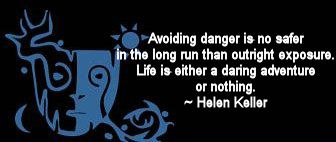|

Marilyn Monroe:
Two-Headed Goddess of the
Age of Electronic Reproduction
by John David Ebert
I.
There she is: Marilyn Monroe, goddess of the silver screen.
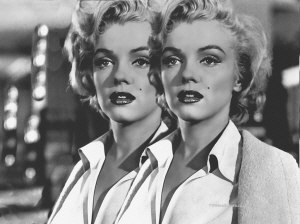 Or perhaps: Marilyn Monroe, two-headed goddess of the silver screen, for as everybody knows, Marilyn had not just one, but rather two names: she was Marilyn Monroe the movie star, but she was also Norma Jeane Baker, the orphan child of suburban Los Angeles. And she had, furthermore, two mothers: a biological mother named Gladys, who disowned her very early on in her life, and the woman who raised Norma Jeane during the latter half of her childhood, Grace McKee, who imprinted upon her the idea that she might become the double of the movie star Jean Harlow. There is, of course, also the name which she chose for her onscreen persona, with its almost deliberate doubling of first initials. (And Marilyn, fittingly, was a Gemini). Or perhaps: Marilyn Monroe, two-headed goddess of the silver screen, for as everybody knows, Marilyn had not just one, but rather two names: she was Marilyn Monroe the movie star, but she was also Norma Jeane Baker, the orphan child of suburban Los Angeles. And she had, furthermore, two mothers: a biological mother named Gladys, who disowned her very early on in her life, and the woman who raised Norma Jeane during the latter half of her childhood, Grace McKee, who imprinted upon her the idea that she might become the double of the movie star Jean Harlow. There is, of course, also the name which she chose for her onscreen persona, with its almost deliberate doubling of first initials. (And Marilyn, fittingly, was a Gemini).
Two heads, then; two identities: one for the silver screen, and one for the real world which, together with its images and ideas, project forth the luminous, flickering puppet plays of the darkened movie cavern.
But a silver screen? According to ancient tradition, silver was the metal associated with the moon. And the moon's light, unlike the sun's, is not self-radiated, but rather projected upon the moon's scarred and rutted canvas from another source, just like the movie screen which receives its light from an exterior source in the movie projector.
Two worlds, then: a dayworld lit by the sun — and to go with it, a daytime persona — and a nightworld opened up by a phantasmal moon lodged in a cavern-shaped sky, with a correspondingly mythical persona to inhabit its shadowy silver-limned grottoes and bowers.
II.
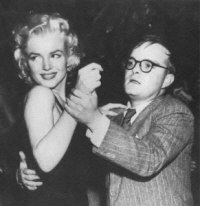 Marilyn Monroe, or rather Norma Jeane, was very much aware of the fact that she was casting her shadow into the light of another world. As Donald Spoto, in his masterful biography, comments: "Truman Capote wrote of finding Marilyn sitting for a long while before a dimly lit mirror. Asked what she was doing, Marilyn replied, 'Looking at her.'" (Spoto, 324) Marilyn Monroe, or rather Norma Jeane, was very much aware of the fact that she was casting her shadow into the light of another world. As Donald Spoto, in his masterful biography, comments: "Truman Capote wrote of finding Marilyn sitting for a long while before a dimly lit mirror. Asked what she was doing, Marilyn replied, 'Looking at her.'" (Spoto, 324)
III.
In Picasso's painting "Woman in Front of a Mirror," we are confronted with a woman rendered in profile who is standing before a full length mirror which she is attempting to adjust, like a telescope on a tripod, for a better view of herself (or, in this case, we should say, into herself). As is so often the case with Picasso's portraits, the woman's face is split like a clamshell into two halves; one of which is a true profile, while the other is a lightly rouged, gold-colored mask that stares directly at us. The mirror, however, does not faithfully duplicate this woman, but rather transforms her into another self, one that stares back with a pale, ashen face whose crescent-shaped wedge reminds one of the moon.
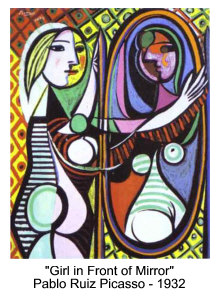 And so, once again, the dual goddess. For Picasso's mirror serves as a chasm opening up the psyche into the dim reaches of its ancient past, where we begin to discern amorphous shapes, shapes which, once the eyes become attuned to the lack of proper lighting, reveal themselves as a series of paired goddesses: there is Inanna, "Mistress of the Great Above," polarized against her dark sister, Ereshkigal, "Mistress of the Great Below"; we can also make out Demeter, bearing her upward-pointing torch while that of her daughter Persephone points downward; and there is Isis, mistress of the throne of the pharaoh, and her sister Nephthys, consort of the underworld god Set. Beyond them loom even more ancient, archaic figures: a cracked lime plaster statue of a woman with two heads which stare with bulging eyes from Neolithic Ain Ghazal; and a tiny white marble figurine from the ruins of Catal Huyuk depicting a goddess with two heads and two sets of breasts, but only two arms. And so, once again, the dual goddess. For Picasso's mirror serves as a chasm opening up the psyche into the dim reaches of its ancient past, where we begin to discern amorphous shapes, shapes which, once the eyes become attuned to the lack of proper lighting, reveal themselves as a series of paired goddesses: there is Inanna, "Mistress of the Great Above," polarized against her dark sister, Ereshkigal, "Mistress of the Great Below"; we can also make out Demeter, bearing her upward-pointing torch while that of her daughter Persephone points downward; and there is Isis, mistress of the throne of the pharaoh, and her sister Nephthys, consort of the underworld god Set. Beyond them loom even more ancient, archaic figures: a cracked lime plaster statue of a woman with two heads which stare with bulging eyes from Neolithic Ain Ghazal; and a tiny white marble figurine from the ruins of Catal Huyuk depicting a goddess with two heads and two sets of breasts, but only two arms.
It is a very old, old image, this vision of the dual goddess — and yet not so old, for we find no traces of such a figure in the dank caverns of Paleolithic Europe. She seems to have emerged in the Neolithic Middle East at just the time when agriculture was trifurcating the cosmos into a three-layered cake of the world above, the world below (from out of which the plants, mysteriously, emerged), and the world of flat-roofed village houses sandwiched in between. (No movies yet; but perhaps, like Indonesian puppet shows, there were plays composed with tiny stick figure protagonists which cast gigantic shadows upon the already crumbling plaster walls by the hearth fires around which the villagers gathered at the end of the day).
IV.
Susan Strasberg recalled walking with [Marilyn] when she noticed a group of fans awaiting her return at the Waldorf. 'Do you want to see me be her?' she asked Susan. Momentarily confused, Susan then saw something remarkable:
She seemed to make some inner adjustment, something turned on inside her, and suddenly — there she was — not the simple girl I'd been strolling with, but "Marilyn Monroe," resplendent, ready for her public. Now heads turned. People crowded around us. She smiled like a kid. (Spoto, 324)
"Marilyn Monroe," then, was a mask put on very deliberately (and ironically) by Norma Jeane Baker, who was conscious all her life of being two women, a real one made of flesh and blood, and an electronically generated construct. The woman we know and refer to today as "Marilyn Monroe" was never confused about this basic fact of her existence, unlike many other, less sophisticated, actors and actresses who are unwittingly swallowed up by their public personae. For contrary to popular belief, there was nothing witless about the real Marilyn Monroe.
V.
In the strange, anamorphic mirror of the Esthonian folk tale "The Wood of Tontla, we find all of this already transformed for us into the pictorial language of myth:
A young girl named Elsie, who is abused by her stepmother and stepsisters, dares to venture into a remote and forbidding part of the woods known as 'Tontla,' which her sisters are terrified of entering. There she is befriended by another young girl (Kiisike) who introduces Elsie to her family and offers to play with her, bringing forth a wooden box full of magical toys containing a mussel shell, two fish bones, and a leaf of lady's smock. Two drops of water on the leaf grow into a big lake, while the mussel shell becomes a boat and the fishbones become oars
[notice that we are here in the presence of the basic iconographic tool kit of the goddess Venus, with her halfshell and her watery birth].
The girls play on the lake for a time, and then Kiisike's family decides to adopt Elsie in a formal ceremony back at the house.
During the ritual, an old man shows up carrying a trough full of clay, which he at once proceeds to mould into a duplicate of Elsie. He punches a hole into the doll's breast and conceals a snake inside of it, then seals it up. He brings the golem to life using a drop of Elsie's blood. This doppelganger of Elsie, which is said to be an exact duplicate of her with the exception that it is impervious to pain, is then sent back to Elsie's house to take her place. Over the years, the stepmother beats the clay doll until one day, just as she is about to choke it to death, the snake emerges from the doll's mouth and bites her on the tongue, killing her. One by one, the rest of Elsie's family meets a similar fate. Elsie, meanwhile, grows up, but one day she is told by her foster mother that she must go forth into the world, whereupon she is transformed into an eagle. The eagle is shot down by a huntsman, but when it falls to the ground, he discovers it to be a beautiful woman, whom he then marries.
Elsie's transformation into an eagle, the classic bird of the sun, is an iconic picture of her role in the daylight world of growth and domesticity, while her dark twin, the clay doppelganger who carries a serpent in her breast, is a miniaturized snake goddess of the nighttime, Hecate or Medea, the Furies or the Gorgon. As in Picasso's painting, it is interesting that it is the lunar goddess of the underworld that is associated with feats of duplication.
The message, then, seems clear: technologically mediated doppelgangers are dangerous and even, according to the folk tale, capable of murder.
VI.
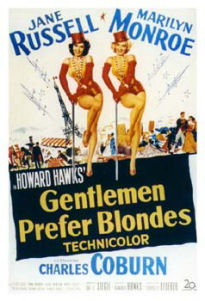 That the foregoing is no mere collection of random associations inspired by a psychoanalytic daydream is confirmed for us by the reiteration of such imagery in Marilyn Monroe's first great film: Gentlemen Prefer Blondes (1953). This was her third starring role after Don't Bother to Knock (1952) and Niagara (1953) (in both films, she played psychopaths) and it was the film that put Marilyn Monroe into the American psyche as a permanent piece of furniture. As the title implies, if gentlemen prefer blondes, they also like brunettes, and from the film's opening image of Marilyn Monroe and Jane Russell paired off together in identical glittering red showgirl dresses, to the double wedding sequence at the film's conclusion, the blonde and the brunette are scarcely ever separated throughout the duration of this film. Indeed, they are together so often that they may as well be Siamese twins. "Two heads are better than one," Jane Russell's character Dorothy Shaw comments, as though to confirm the appropriateness of the metaphor. That the foregoing is no mere collection of random associations inspired by a psychoanalytic daydream is confirmed for us by the reiteration of such imagery in Marilyn Monroe's first great film: Gentlemen Prefer Blondes (1953). This was her third starring role after Don't Bother to Knock (1952) and Niagara (1953) (in both films, she played psychopaths) and it was the film that put Marilyn Monroe into the American psyche as a permanent piece of furniture. As the title implies, if gentlemen prefer blondes, they also like brunettes, and from the film's opening image of Marilyn Monroe and Jane Russell paired off together in identical glittering red showgirl dresses, to the double wedding sequence at the film's conclusion, the blonde and the brunette are scarcely ever separated throughout the duration of this film. Indeed, they are together so often that they may as well be Siamese twins. "Two heads are better than one," Jane Russell's character Dorothy Shaw comments, as though to confirm the appropriateness of the metaphor.
Marilyn Monroe plays Lorelei Lee, a gold digger who is interested in men only for their money, while Dorothy Shaw is a romantic who is forever dreaming of erotic possibilities. Thus, Lorelei's concerns are those of the dayworld of social prestige and achievement, while Dorothy's erotic inclinations are more suitable to the nighttime and the bedroom. The film's plot is a chronicle of the two women traveling on board a luxury liner headed for France, and in one scene, Dorothy strolls on deck accompanied by a man with whom she suspects she might fall in love. The two comment on the beauty of the moon while the man attempts to kiss her. (She is wearing a black dress, while Lorelei, on the same night, is briefly glimpsed wearing a gold dress).
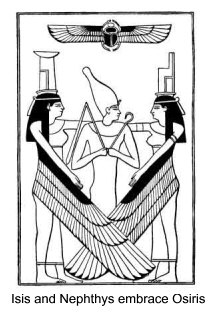 There is, furthermore, a musical number that occurs early in the film in which Dorothy is knocked into a pool by a group of leaping Adonis-like swimmers who hurl themselves over her head and into the water. The association of the goddess of the night and the underworld with the cosmic watery abyss is traditional. In the pair of goddesses represented in ancient Egypt as Isis and Nephthys, it is Isis whose primary icon is the throne and hence she is linked with the daylight world of courtly intrigue and kingship, while her sister Nephthys is signified by a cup of liquid, pointing to her association with the watery abyss which in Egyptian cosmology surrounds the earth, and from out of which it emerged. Thus, the filmmakers, in a naìve way, got the tradition right: the blonde = the sun, the social world, and the quotidian concerns of daily life; the brunette = the moon and the night, the realm of the genitals and their hidden, indoor rituals which have the effect of bringing the dayworld into being. (And though the milieu is highbrow, Wagner's understanding in his operas Tannhauser and Tristan and Isolde is exactly the same: in the former opera, Tannhauser's courtly betrothed Elizabeth is played off against his real love, the goddess Venus, who detains him inside the dark caverns of her mountain, while in Tristran and Isolde, Tristan's moon-intoxicated love for Isolde —which leads to his shameful betrayal of his king— is polarized against the courtly dayworld of King Mark, the realm of honor, and prestige and reputation, all of which Tristan sacrifices upon the altar of his passion for Isolde). There is, furthermore, a musical number that occurs early in the film in which Dorothy is knocked into a pool by a group of leaping Adonis-like swimmers who hurl themselves over her head and into the water. The association of the goddess of the night and the underworld with the cosmic watery abyss is traditional. In the pair of goddesses represented in ancient Egypt as Isis and Nephthys, it is Isis whose primary icon is the throne and hence she is linked with the daylight world of courtly intrigue and kingship, while her sister Nephthys is signified by a cup of liquid, pointing to her association with the watery abyss which in Egyptian cosmology surrounds the earth, and from out of which it emerged. Thus, the filmmakers, in a naìve way, got the tradition right: the blonde = the sun, the social world, and the quotidian concerns of daily life; the brunette = the moon and the night, the realm of the genitals and their hidden, indoor rituals which have the effect of bringing the dayworld into being. (And though the milieu is highbrow, Wagner's understanding in his operas Tannhauser and Tristan and Isolde is exactly the same: in the former opera, Tannhauser's courtly betrothed Elizabeth is played off against his real love, the goddess Venus, who detains him inside the dark caverns of her mountain, while in Tristran and Isolde, Tristan's moon-intoxicated love for Isolde —which leads to his shameful betrayal of his king— is polarized against the courtly dayworld of King Mark, the realm of honor, and prestige and reputation, all of which Tristan sacrifices upon the altar of his passion for Isolde).
Gentlemen Prefer Blondes also sets up the pop culture archetype of the dumb blonde and the smart brunette who must solve all her problems for her. This is a trope that continues all the way down to the seventies TV show Three's Company, in which the dumb blonde Chrissy, finds her foil in the smart brunette Janet, who is forever providing her with escape routes for her erotic entanglements. (Three's Company? If the two women in this show correspond to the dual goddess, then what about their roommate Jack Tripper? He is, of course, Triptolemus, the boy child in the care of Demeter to whom she teaches the arts of agriculture and the plough [which becomes, in visual art, his phallic symbol; and no character was ever more ithyphallic than Jack Tripper, whose name implies that he is constantly tripping over his own erect phallus]. Demeter, Persephone and Triptolemus, then, were really a threesome in Classical Mythology).
With this film, the electronically generated movie star known as "Marilyn Monroe" is born, for it was in Gentlemen Prefer Blondes that Marilyn's persona as a ditzy blonde forever appearing to be at the mercy of the men around her is established. Marilyn had already appeared in this persona in bit roles in films like All About Eve and Monkey Business, but Gentlemen Prefer Blondes is the film that forever typecast her as an actress, and she will spend the rest of her life battling to rid herself of this persona.
VII.
Of all the prostheses that mark the history of the body, the double is doubtless the oldest. But the double is precisely not a prosthesis: it is an imaginary figure, which, just like the soul, the shadow, the mirror image, haunts the subject like its other. The subject is simultaneously itself and never resembles itself again, which haunts the subject like a subtle and always averted death. This is not always the case, however: when the double materializes, when it becomes visible, it signifies imminent death. (Baudrillard, 95)
VIII.
"The feeling of strangeness that overcomes the actor before the camera...is basically of the same kind as the estrangement felt before one's own image in the mirror. But now the reflected image has become separable, transportable. And where is it transported? Before the public." (Benjamin, 230-231) Thus, Walter Benjamin in his famous essay on the work of art in the age of its mechanical reproducibility.
This separation of one's own mirror image from one's physical self is tantamount to the creation of a clone of oneself that, by means of its very transportability, takes on its own life and becomes entirely independent of the actor who generated it. As Benjamin elaborates, this is not an act without consequences for the actor or his art:
This situation might also be characterized as follows: for the first time — and this is the effect of the film — man has to operate with his whole living person, yet foregoing its aura. For aura is tied to his presence; there can be no replica of it. The aura which, on the stage, emanates from Macbeth, cannot be separated for the spectators from that of the actor. However, the singularity of the shot in the studio is that the camera is substituted for the public. Consequently, the aura that envelops the actor vanishes, and with it the aura of the figure he portrays. (Benjamin, 229)
For Benjamin, the word, aura, has a special significance, for it is a sort of magical property tied to specific things, persons or works of art, and is intimately bound up with their history and their specific form of "thereness." Aura, however, is not something that can be captured in a reproduction of any kind, mechanical, electronic, or otherwise. When a work of art is mass reproduced, the reproduction excludes the aura of the original that it copies; and not only that, but the multiplicity of the reproduction actually has a damaging effect on the aura of the original. In Benjamin's phraseology, technological mass reproduction causes the aura of the original to decay through over-familiarity of the image on the part of the mass public. After all, who wants to look at the real Mona Lisa in a museum when we've seen it almost every day on T-shirts, coffee cups, and television shows?
Something similar would seem to apply to actors in film. In this case, the actor corresponds to the original work of art which, through electronic over-reproduction, begins to suffer from a strange kind of psychological decay. From the point of view of the actor, the psychological effects of being stripped repeatedly of his or her own image via electronic reproduction are experienced as a state of utmost disorientation. The public becomes familiar with the mass produced image, not the real actor, and consequently, it expects the actor to exist, to be, in a specific way, and the more narrow those expectations become, the more strait-jacketed the actor begins to feel.
Thus, Marilyn Monroe's lifelong battle against the decay of her own aura as a result of the growth and flourishing of her electronic persona became a fight to preserve her own sanity. The gradual increase over time in her use of barbiturates to help her sleep at night; mounting anxieties over her performance in front of a camera; her almost pathological hand-wringing at her desire to be accepted and admired by the public; all acted as a kind of psychological entropy that became worse with time, ultimately resulting in the mental catastrophe that landed her in an insane asylum.
But this event, of course, was the outcome of a plot hatched by her own doppelganger to get rid of the real flesh and blood Marilyn. For, languishing in the Payne Whitney Clinic in New York, where she was locked up inside a padded room, Marilyn was kidnapped by her electronic double who saw to it that she be locked safely away from public view. This way, her doppelganger could be free to live its own life basking in the admiration of the public without having to worry about whether the real Marilyn would attempt to sabotage her fame by putting her to rest inside some costume closet in the dark corner of a forgotten studio backlot.
IX.
It could be said that Benjamin's analysis of the non-reproducibility of an actor's aura misses a certain point, since it was by means of the very technological process of filming and then projecting upon a gigantic screen the images of actors like James Dean, Marilyn Monroe and Marlon Brando that conferred upon them auras of mythic grandeur which they would not otherwise have possessed. Benjamin did not understand the essentially myth-making power of film.
That point aside, then, we are confronted with the mythical gigantism of the celluloid version of Marilyn Monroe, for it is crucial to realize that absolutely anything that is put through the sieve of filmic technology —actors, narratives, or what have you — is instantly transformed into mythic spectacle. And the onscreen persona of Marilyn Monroe is a case in point, for it is an obvious retrieval of the ancient goddess Venus, just as Elvis Presley's television persona was a pixilated reconstruction of the Greek god Dionysus. Indeed, there is a certain symmetry between these two figures, for Marilyn Monroe was to the male psyche the exact inverse equivalent of what Elvis Presley was to the female psyche, both personae had an intense and compulsively erotic effect on their opposite sexes.
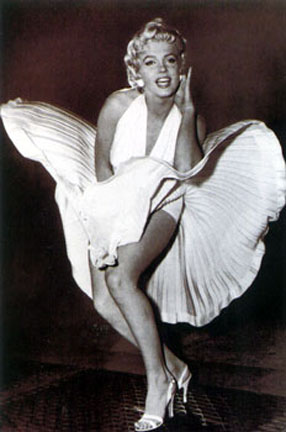 Nowhere is Marilyn-as-Venus more evident than in the Billy Wilder comedy The Seven Year Itch (1955). Seven year cycles are a normal part of the 28 year sidereal cycles of the planet Saturn, which squares itself astrologically every seven years. And in Hesiod's Theogony, Saturn is, in a way, the father of Aphrodite since he cuts off his father Ouranos's genitals and then tosses them into the ocean, whereupon they foam (aphros) and produce Aphrodite herself, the mistress who rules over the genitals. In Billy Wilder's film, a seven year cycle does indeed bring forth the goddess Venus in the form of Marilyn's character known simply as The Girl, a woman who lives in the apartment directly above that of the film's protagonist Richard Sherman. Sherman's family has gone away on summer vacation and now he is beginning to feel a seven year marriage itch that manifests itself as a twitching of his thumb (which is interesting, because according to traditional chiromancy, the thumb is assigned to Venus, just as the index finger corresponds to Jupiter, the middle finger to Saturn, the ring finger to Apollo and the pinky to Mercury). Thus, when The Girl descends from her apartment to visit him, it is like a visitation from a goddess, for her presence is hilariously unsettling to him. Nowhere is Marilyn-as-Venus more evident than in the Billy Wilder comedy The Seven Year Itch (1955). Seven year cycles are a normal part of the 28 year sidereal cycles of the planet Saturn, which squares itself astrologically every seven years. And in Hesiod's Theogony, Saturn is, in a way, the father of Aphrodite since he cuts off his father Ouranos's genitals and then tosses them into the ocean, whereupon they foam (aphros) and produce Aphrodite herself, the mistress who rules over the genitals. In Billy Wilder's film, a seven year cycle does indeed bring forth the goddess Venus in the form of Marilyn's character known simply as The Girl, a woman who lives in the apartment directly above that of the film's protagonist Richard Sherman. Sherman's family has gone away on summer vacation and now he is beginning to feel a seven year marriage itch that manifests itself as a twitching of his thumb (which is interesting, because according to traditional chiromancy, the thumb is assigned to Venus, just as the index finger corresponds to Jupiter, the middle finger to Saturn, the ring finger to Apollo and the pinky to Mercury). Thus, when The Girl descends from her apartment to visit him, it is like a visitation from a goddess, for her presence is hilariously unsettling to him.
In the iconic scene in which The Girl stands above the subway grille while its rush of air blows her skirt about, Marilyn's identity as Venus is confirmed, for the image is an almost exact retrieval of Botticelli's 1483 painting The Birth of Venus. In that painting Venus stands upon a half-shell rather than a grille (the half-shell is a symbol of the vulva, a fact which is more evident in the Roman copy of Apelles' now lost painting of Venus Anadyomene, in which the shell's interior is painted pink). In Botticelli's version, the newborn Venus is blown toward the shore from the left by the zephyrs, the winds, while on the shore waiting to receive her is one of the Horae, goddesses of the seasons, who offer a cloak to her which is waving and furling in the winds blown by the zephyrs. Thus, if the painting is rotated ninety degrees to the left, then the direction of the winds is coming as if it were from below, while the garment is blowing above it. This corresponds very closely to the image of Marilyn Monroe standing on the subway grille while her skirt erupts all around her (and note that the position of Marilyn's hands is about the same as that of the Venus pudica style upon which Botticelli modeled his Venus). In this one celluloid image, Marilyn becomes the Venus of the Metropolis, the goddess of the genitals retrieved and fully updated for the modern world.
X.
So why did Marilyn Monroe's doppelganger contrive to have her locked away in a padded cell? This incarceration took place in 1961, but it was the response to Marilyn's repeated attempts, upon leaving Twentieth Century Fox in 1955, to destroy and ruin her doppelganger's very existence. This began with Marilyn's attempt to perform an operation of excision upon her Siamese twin in the 1956 film Bus Stop. This was the first film she made after leaving Hollywood to go and study at the Actor's Studio in New York, and it is a deliberate attempt to forge for herself a reputation as a serious actress, and so to put an end to her twin's life. (This moment in her career corresponds to that of Elvis Presley's when he sought to restore his early Ed Sullivan image by appearing in his '68 Comeback Special for television. The difference, however, was that Elvis was attempting to repair the electronic persona that had made him famous and which had been frayed by a string of bad movies, whereas Marilyn Monroe in Bus Stop was performing an act of demolition upon the electronic persona that had brought her so much recognition as a comedic actress).
There is a scene early on in this film which synopsizes what Marilyn is up to with regard to her old image: her character, a show girl, sings "That Old Black Magic" to a crowd of cowboys in a dusty, smoke-stained bar in Phoenix, Arizona. Her routine evokes a scene that is at first glance familiar to us, for in film after film, she had played a show girl who performed glitzy Hollywood musical numbers before an audience dazzled by her virtuosity. But upon closer inspection, it becomes evident that this performance differs fundamentally from all her others, for in it, she makes every effort to ravage her by then all too familiar persona: she is garbed in a moth-eaten outfit and her singing is so bad that it can barely be heard above the disinterested chatter of the cowboys. In a conscious allusion, furthermore, to the high-gloved pink outfit she had worn for "Diamonds Are a Girl's Best Friend" in Gentlemen Prefer Blondes, her ill-fitting long-armed gloves keep sliding down her shoulders and she has to keep pulling them back up. This is not the vivid persona whose colorful, Van Gogh-like luminosity had hypnotized us in her earlier films, for this woman is as crinkled and used as an old road map. She wears little make-up, and indeed, she is so pale as to appear bleached by the hot Phoenix sun.
Bus Stop is Marilyn's first attempt at a demolition of her own electrically created image, and it very nearly succeeds. But the success was strictly temporary, for soon after, she was engulfed once more by stereotyped roles in films like Some Like It Hot (1959) and Let's Make Love (1960). As the myths and folk tales tell us, doppelgangers do not die easily, and Marilyn Monroe's would soon have its final revenge upon her.
XI.
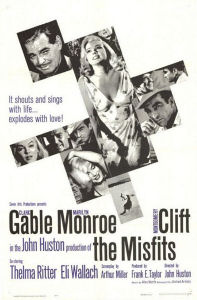 But before that could take place, she completed one final film with one last attempt at an erasure of that same persona. In The Misfits (1961), the Venus of the Metropolis ventures out into the stark white wilderness of the Nevada desert, where she changes roles —and cults— to become the Lady of the Wild Things, known as Artemis (Latin Diana) in the Classical World, Ninhursag ("Lady of the stony ground") in the Sumerian and Neith (the patron goddess of hunters) in the Egyptian. For in this film, she journeys out to the desert with three cowboys, each of whom is in love with her, in order to accompany them on a hunt for wild mustang horses which the cowboys intend to sell to dealers who will in turn sell them to be turned into dog food. The film's climactic sequence, in which Marilyn decries the brutal trapping of these slat-ribbed and starving horses against the bone white backdrop of the Nevada salt flats is a brilliant elegy for the death of the genre of the Western, which would be essentially moribund within a decade of the film's release. The images of the cowboys stalking their prey using a biplane (in order to scare them) and a pickup truck to tie them down is a haunting and pathetic evocation of the final degradation of the old West, ground down into salt by the churning mill of industrial civilization. Marilyn's character realizes this, and the vision of her tiny figure — dwarfed by the ancient and almighty emptiness of the desert — screaming to a black and white sky is not only a wail of tortured compassion for the horses, but a scream against the violence and brutality inflicted upon ancient ways of life by industrial society. But before that could take place, she completed one final film with one last attempt at an erasure of that same persona. In The Misfits (1961), the Venus of the Metropolis ventures out into the stark white wilderness of the Nevada desert, where she changes roles —and cults— to become the Lady of the Wild Things, known as Artemis (Latin Diana) in the Classical World, Ninhursag ("Lady of the stony ground") in the Sumerian and Neith (the patron goddess of hunters) in the Egyptian. For in this film, she journeys out to the desert with three cowboys, each of whom is in love with her, in order to accompany them on a hunt for wild mustang horses which the cowboys intend to sell to dealers who will in turn sell them to be turned into dog food. The film's climactic sequence, in which Marilyn decries the brutal trapping of these slat-ribbed and starving horses against the bone white backdrop of the Nevada salt flats is a brilliant elegy for the death of the genre of the Western, which would be essentially moribund within a decade of the film's release. The images of the cowboys stalking their prey using a biplane (in order to scare them) and a pickup truck to tie them down is a haunting and pathetic evocation of the final degradation of the old West, ground down into salt by the churning mill of industrial civilization. Marilyn's character realizes this, and the vision of her tiny figure — dwarfed by the ancient and almighty emptiness of the desert — screaming to a black and white sky is not only a wail of tortured compassion for the horses, but a scream against the violence and brutality inflicted upon ancient ways of life by industrial society.
It seems somehow appropriate that Marilyn Monroe —the patron goddess of cities— winds down her career with Bus Stop and The Misfits, both of which films concern journeys to the deserts of the Southwest, where urban civilization is even today still just a thin and precarious wafer covering a vast, enervating wilderness of violent rocks and jagged cliffs. Here, Marilyn's character —perhaps the closest she has ever come to actually playing herself — is a sad, sullen pale wreck of a woman who radiates depression even when she is smiling. It is almost as though the desert itself has robbed her of her vitality, just as it has nearly ground down the handful of paltry horses which is all that the cowboys are able to muster up. Such ennui is precisely what one expects of a cultural cycle that is spiraling down toward its end.
In The Misfits Marilyn signs off with a despairing image of the limits of industrial civilization and a revelation from the desert of its coming end, for the nobility of the terrified horses, who refuse to be tamed, suggest that it is the creatures of the hinterlands which will ultimately prevail against the concrete and metallic skeletons which Western man, possessed by the fever dream of remaking the cosmos in the image of a machine, has temporarily erected.
XII.
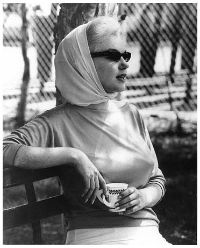 And so the end comes, inevitably, for Marilyn's doppelganger will tolerate no more of these attempts to efface her presence in the electric universe. She has devised a plan; a plan which, this time, will succeed in killing off the real Marilyn Monroe once and for all. No one will remember her as she really was: Norma Jeane sitting in her apartment reading her beloved Tolstoy or Dostoevsky; writing poetry; planning escape routes through other celluloid vehicles that would bear her safely beyond the harmful reach of her own stereotype. It is only the smiling, glitzy, ditzy Marilyn Monroe of the photographs and the magazine covers and the movie posters that anyone will remember. It is only this Marilyn, split from the bone core of the real Marilyn by means of the camera eye, who will be adored by the future. And so the end comes, inevitably, for Marilyn's doppelganger will tolerate no more of these attempts to efface her presence in the electric universe. She has devised a plan; a plan which, this time, will succeed in killing off the real Marilyn Monroe once and for all. No one will remember her as she really was: Norma Jeane sitting in her apartment reading her beloved Tolstoy or Dostoevsky; writing poetry; planning escape routes through other celluloid vehicles that would bear her safely beyond the harmful reach of her own stereotype. It is only the smiling, glitzy, ditzy Marilyn Monroe of the photographs and the magazine covers and the movie posters that anyone will remember. It is only this Marilyn, split from the bone core of the real Marilyn by means of the camera eye, who will be adored by the future.
And it is this Marilyn, the other Marilyn, the one that gazed back at her from the depths of the polished mirror and the dark caverns of the cool and remote theaters, who will make certain of this.
XIII.
Donald Spoto, in his biography of Marilyn Monroe, presents us with a convincing theory for her death, one that overrides the popular conceptions of a suicide by drug overdose. As he points out, Marilyn in her last days had no reason to commit suicide: she had just made a number of new picture deals, one of which was to involve her playing Jean Harlow in a bio-pic, and she had agreed to remarry Joe Dimaggio. Contrary to her despairing persona in The Misfits, the photo sessions that were taken subsequent to that film show a bright, smiling, radiant woman just on the threshold of leaving her youthful beauty behind and beginning to transition into a mature and wise older woman. Indeed, Douglas Kirkland's photographs of her in milk-white sheets soaked with studio light reveal an almost ethereal, delicate being structured out of patterns of luminescence. The black aura of depression does not darken her in these photographs, and suicide does not seem consistent with the events of these final days.
Something else seems to have happened, something more sinister and ominous than suicide, but yet more banal and pathetic than some FBI/Kennedy plot. Rather, Spoto suggests that her death may have been the result of an "accidental" overdose given to her by her creepy psychiatrist, a man named Dr. Ralph Greenson, a man who was, apparently, obsessed with her.
Greenson entered her life very late (this was in 1960), but his possession of her was immediate and almost total. At first, he received her in his office five days a week, but then this expanded to seven; finally, he arranged for her to move in with him and his family. Marilyn's trust in this man was just about complete, and so she did nearly everything he asked her to do, including turning down film roles that might have advanced her career in the direction she wanted. Prior to taking on Marilyn, Greenson had been a sort of Hollywood psychiatrist for the stars, but when Marilyn came his way, he quickly dropped all his other clients. When she decided to move into her own house, he advised her to take on as a housekeeper an older woman named Eunice Murray whom, although she was not medically trained, Greenson had been working with for years as a patient supporter. Marilyn did, indeed, take Eunice on as a live-in housekeeper, but it became immediately apparent to Marilyn's friends that Eunice was just a spy for Dr. Greenson, for she was frequently seen telephoning him to report on Marilyn's activities and whereabouts. And according to Spoto, whenever Marilyn would come too close to bonding with other potential mentors, Greenson would advise her to put an end to the relationships. Both Eunice and Greenson acted as forbidding obstacles to her friends, slowly and gradually isolating her. Eunice would often discourage phone calls and visits from Marilyn's friends without her knowledge. When Marilyn learned that Eunice was going so far as to have her mail held at the post office, Marilyn decided to get rid of her and fired her (twice).
Indeed, the day of Marilyn's death was to be Eunice's last day of employment in her service. And not only that, but Marilyn, after agreeing to remarry Joe Dimaggio, had decided to sever all ties with Dr. Greenson. It is possible that on the day of her death, she told him this, since he was reportedly with her at her house for most of the day.
On that day, Marilyn was tired because she had not slept the night before, and she had been taking Nembutal throughout the day in an attempt to get some sleep. At around 7:20 p.m., Joe Dimaggio's son telephoned and found her bright and talkative. They spoke for about ten minutes. But then, at around 7:45, on the phone with her friend Peter Lawson, it was evident to him that something terrible had happened, because she was slurring her words and was nearly incoherent. Even more alarmingly, she began a litany of goodbyes that faded off into silence.
According to Spoto, Marilyn's death was the result of a lethal interaction between two drugs, Nembutal and chloral hydrate. Apparently, Dr. Greenson did not know that the doctor he normally consulted to administer Marilyn's drugs had re-started her on Nembutal, which Greenson thought he had weaned her from. Not knowing this, he advised giving her a chloral hydrate enema to help her sleep, and Spoto theorizes that the housekeeper, Eunice Murray, was the only person around who could have administered it. Within minutes, the drug interaction had killed her, and Eunice and Greenson found themselves in a suddenly drastic situation. They attempted to cover up with a number of contrived and inaccurate stories about finding her dead body to which nobody paid too much attention because Eunice was an old woman and Dr. Greenson a respected doctor. (The police were not called, for instance, until nearly five o'clock in the morning, while Eunice initially claimed she had found Marilyn's body just before midnight, but then later changed her story to say that she had found her at around 3:00 a.m.)
Marilyn's death, then, may well have been an accident. On the other hand, it seems clear that Dr. Greenson fits the profile of a type of modified celebrity stalker, albeit a respected and trusted one (at least by Marilyn). In the light of Marilyn's firing of Eunice and then telling Dr. Greenson that she didn't want anything further to do with him, one is given pause to contemplate the timing of how swiftly her accidental death at their hands soon followed. It would appear more likely that, even if only unconsciously, Greenson decided that if he couldn't have Marilyn, then no one would. At one point in his narrative, Spoto himself even hints that her death at Greenson's hands may not have been such an accident:
Weary of interrupting his personal life to deal with the struggles of his primary patient — an involvement he had himself worked hard to create — he was at the end resentful that Marilyn was withdrawing from his orbit, was moving out of his control, toward Joe and therefore away from him. Having spun for himself the mantle of guardian and protector, father and caregiver, he found it was an intricate web. He had worked tirelessly to limit Marilyn's outside contacts, to make his devotion her only love and his care her only support. In any relationship, this is a dangerous program; in a therapeutic situation, it is catastrophic.
Her imminent departure was intolerable to him, the ultimate rejection by his ultimate patient. He considered her, therefore, as one who failed to be his, and in the end he treated her just as such a man would: capriciously, placing her in a perilous situation. In some dark corner of his mind, he may have known or feared or even wished that his temerity would lead to tragedy. (Spoto, 592)
If Spoto's theory is correct, then Marilyn's death was not a suicide and probably not even an accident, but the direct result of a celebrity stalker's obsessions which ended with her death at his hands. Indeed, Greenson and his accomplice, Eunice Murray, remind one of nothing so much as the demons out of Manichean myth who are jealous of the beings of the Kingdom of Light and so, when those luminous beings descend to the material world, the demons kill and devour them, wishing to possess their light inside themselves.
Little Red Hiding Hood, too, suffered a similar bedside fate at the hands of the Big Bad Wolf who, in some versions of the story, simply swallowed her alive.
XIV.
Thus, in the end, Marilyn Monroe's electric doppelganger had her revenge and contrived to eliminate the real Marilyn Monroe from the physical world. In order to do this, it became necessary to seize possession of the personality of Dr. Greenson and haunt his dreams and fantasies to the point where it became impossible for him not to possess the real Marilyn Monroe. That is, Greenson was compelled to possess her because he, in turn, had been taken hostage by Marilyn's doppelganger who wished to eliminate her rival from the material world altogether. That way, the real Marilyn, the Marilyn Monroe whose aura had been stripped from her and given a kind of etheric substance by means of the cold electric gaze of the camera eye, would never again be able to attempt to perform an act of demolition upon her.
Works Cited
Baudrillard, Jean. Simulacra and Simulation. Ann Arbor: University of Michigan Press, 2006.
Benjamin, Walter. Illuminations. NY: Shocken Books, 1969
Spoto, Donald. Marilyn Monroe: The Biography. NY: Cooper Square Press, 2001.
 John David Ebert is a former editor for the Joseph Campbell Foundation. He wrote footnotes for Baksheesh & Brahman, Sake & Satori and The Mythic Dimension, all posthumous publications of Campbell's writings. His first book was Twilight of the Clockwork God: Conversations on Science and Spirituality at the End of an Age John David Ebert is a former editor for the Joseph Campbell Foundation. He wrote footnotes for Baksheesh & Brahman, Sake & Satori and The Mythic Dimension, all posthumous publications of Campbell's writings. His first book was Twilight of the Clockwork God: Conversations on Science and Spirituality at the End of an Age (Council Oak Books, 1999). His most recent book is entitled Celluloid Heroes & Mechanical Dragons: Film as the Mythology of Electronic Society
(Council Oak Books, 1999). His most recent book is entitled Celluloid Heroes & Mechanical Dragons: Film as the Mythology of Electronic Society (Cybereditions, 2005), and was reviewed by Dr. William Doty in the August 2005 issue of Mythic Passages. His work has been published in various periodicals such as Utne Reader, The Antioch Review, Lapis and Alexandria. He is currently working on a book about popular culture and mythology, tentatively entitled Electric Demigods of the Lightspeed World. (Cybereditions, 2005), and was reviewed by Dr. William Doty in the August 2005 issue of Mythic Passages. His work has been published in various periodicals such as Utne Reader, The Antioch Review, Lapis and Alexandria. He is currently working on a book about popular culture and mythology, tentatively entitled Electric Demigods of the Lightspeed World.
Read more by John Ebert at his website cinemadiscourse.com
Read more about Marilyn Monroe at www.marilynmonroe.com
Return to Passages Menu
Subscribe to the Passages e-zine
|
